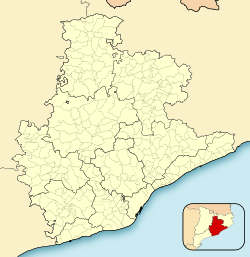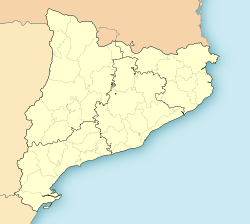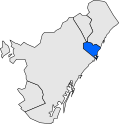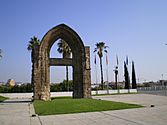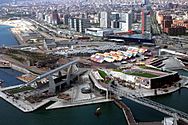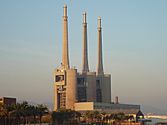Sant Adrià de Besòs facts for kids
Quick facts for kids
Sant Adrià de Besòs
|
|||
|---|---|---|---|
|
Municipality
|
|||
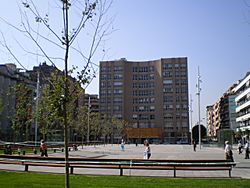
Plaça de la Vila dominated by the city hall
|
|||
|
|||
| Country | |||
| Community | |||
| Province | Barcelona | ||
| Comarca | Barcelonès | ||
| Judicial district | Badalona | ||
| Boroughs |
6 neighbourhoods
Sant Adrià Nord
Sant Joan Baptista La Verneda La Catalana El Besòs La Mina |
||
| Government | |||
| • Type | Mayor–council | ||
| • Body | Ajuntament de Sant Adrià de Besòs | ||
| Area | |||
| • Total | 3.8 km2 (1.5 sq mi) | ||
| Highest elevation | 14 m (46 ft) | ||
| Lowest elevation | 0 m (0 ft) | ||
| Population
(2018)
|
|||
| • Total | 36,669 | ||
| • Density | 9,650/km2 (25,000/sq mi) | ||
| Demonym(s) | Adrianenc, adrianenca (ca) Adrianense (es) |
||
| Postal code |
08930
|
||
| Area code(s) | (+34) 93 381 | ||
| Statistical code | 081944 | ||
Sant Adrià de Besòs is a city and a municipality in Catalonia, north-eastern Spain. It is located on the Mediterranean coast. The city sits at the mouth of the Besòs River. The original part of the town is on the left bank of the river.
Sant Adrià is the smallest municipality in the Barcelonès area. It is very close to Barcelona, Badalona, and Santa Coloma de Gramenet. These cities form one large urban area. Today, Sant Adrià is mostly known for its service sector. It also has many different factories. These factories work with metal, chemicals, and construction. Most of them are medium-sized companies.
Over time, many people have moved to Sant Adrià. This happened because of the growth of factories in the last century. The city has also gone through many big makeovers. In 2004, Sant Adrià de Besòs was part of the Universal Forum of Cultures.
Contents
Discovering Sant Adrià's Past
The city of Sant Adrià de Besòs started around a church. This church was first mentioned in the year 1012. Around 1092, a group of Augustinian monks built a priory there. This priory was connected to Sant Ruf d'Avinyo.
A famous person named Saint Olegarius lived in this priory. He was there from 1095 to 1108. After that, he became a bishop in Barcelona. Later, he became an archbishop in Tarragona. In 1127, the monks moved their priory to Santa Maria de Terrassa. The first village grew around this church. It was on a small hill, about fourteen meters high. This hill was west of the Besòs River.
Getting Around Sant Adrià
Sant Adrià de Besòs is very close to Barcelona. This means it has great connections for roads, trains, and other public transport options. It is a key part of the transport system in the Barcelona metropolitan area.
For many years, Sant Adrià was not a rich town. It was also very crowded. Public transport improvements around Barcelona did not affect it much. But recently, new public infrastructure and city makeovers have brought big changes. This is especially true for the tram services.
Major Roads and Highways
The C-31 highway comes from Barcelona to Mataró. It crosses the Ronda del Litoral (B-10 motorway) in the middle of Sant Adrià. This creates a major highway interchange. It also links the B-10 to the Ronda de Dalt (B-20 motorway). This link happens at Nus de la Trinitat, another big interchange in northern Barcelona.
Other important roads in Sant Adrià include the N-II national route. This road runs along the Maresme coastline. There is also the local road BV-5001. It goes towards Montornès del Vallès and La Roca del Vallès. This road crosses the northern part of the city.
Public Transport Options
The public transport network mainly uses many city and intercity bus routes. These buses help people travel within Sant Adrià. They also connect the city to other nearby towns. Currently, 16 bus routes pass through Sant Adrià. Five of these are local routes run by Transports Metropolitans de Barcelona (TMB). They go to and from Barcelona. Eight are intercity routes within Barcelonès. Three are night bus routes.
For train travel, the Trambesòs is the most important system in Sant Adrià. It has 7 stops within the city. All its routes serve these stops. The tram connects Sant Adrià to the Sant Martí district in Barcelona. It goes all the way to Parc de la Ciutadella.
The Maresme Line also runs through the city. The Sant Adrià de Besòs railway station is the only stop on this line in town. It is in the eastern part of Sant Adrià. This station is served by the Rodalies de Catalunya commuter rail line R1.
Verneda is the only Barcelona Metro station officially in Sant Adrià. However, the Artigues – Sant Adrià station also serves the city. Even though it is in Badalona, it is only a few meters from Sant Adrià's border.
Cool Places to Visit in Sant Adrià
Sant Adrià de Besòs has some interesting places to explore. Here are a few you might like:
- History of Immigration in Catalonia Museum (MhiC): This museum helps us understand the history of people moving to Catalonia. Most of these people came from the Iberian Peninsula. The museum has a space for special exhibitions. It also has a research center and a virtual museum. A cool part is El Sevillano. This is a restored passenger train car. Many immigrants used it in the 1950s and 1960s to travel from southern Spain to Barcelona.
- Parish Church of Sant Adrià de Besòs: This church was built in the 1940s. It has a brick veneer front. Inside, there is a large main room called a nave. On each side of the nave, there are chapels. The church also has a round end part called a semicircular apse and a dome. Two towers stand on either side of the front. The tallest one is the bell tower.
- Air-raid shelter: The air-raid shelter under Francesc Macià Square is one of four public shelters built during the Spanish Civil War. It is located under the square. It is also very close to the old Industrial Baurier factory. Factories were often targets during the war. This shelter could hold 80 to 100 people. It was finished in August 1938. It was closed in Francoist Spain in March 1939. The shelter reopened on September 11, 2006, after being fixed up. It became a museum on January 27, 2008. Today, the shelter has five exhibition areas and an entrance hall. It helps people learn about the Civil War and the time after it in Sant Adrià.
Sant Adrià's Weather
| Climate data for Sant Adrià de Besòs (data from 1902-1972) | |||||||||||||
|---|---|---|---|---|---|---|---|---|---|---|---|---|---|
| Month | Jan | Feb | Mar | Apr | May | Jun | Jul | Aug | Sep | Oct | Nov | Dec | Year |
| Mean daily maximum °C (°F) | 13.5 (56.3) |
14.4 (57.9) |
16.7 (62.1) |
19.4 (66.9) |
22.2 (72.0) |
25.2 (77.4) |
29.0 (84.2) |
28.9 (84.0) |
26.9 (80.4) |
23.0 (73.4) |
17.0 (62.6) |
13.8 (56.8) |
20.8 (69.4) |
| Daily mean °C (°F) | 8.6 (47.5) |
9.2 (48.6) |
11.6 (52.9) |
14.2 (57.6) |
17.1 (62.8) |
20.4 (68.7) |
23.9 (75.0) |
23.9 (75.0) |
21.9 (71.4) |
17.8 (64.0) |
12.3 (54.1) |
9.4 (48.9) |
15.9 (60.6) |
| Mean daily minimum °C (°F) | 3.7 (38.7) |
4.0 (39.2) |
6.6 (43.9) |
8.9 (48.0) |
12.0 (53.6) |
15.6 (60.1) |
18.8 (65.8) |
18.9 (66.0) |
16.9 (62.4) |
12.5 (54.5) |
7.6 (45.7) |
5.0 (41.0) |
10.9 (51.6) |
| Source: Sistema de Clasificación Bioclimática Mundial | |||||||||||||
Population of Sant Adrià
| 1990 | 2000 | 2001 | 2002 | 2003 | 2004 | 2005 | 2006 | 2007 | 2008 | 2009 | 2010 | 2011 |
|---|---|---|---|---|---|---|---|---|---|---|---|---|
| 34,729 | 32,452 | 32,439 | 32,641 | 32,845 | 32,921 | 32,940 | 32,585 | 32,734 | 33,223 | 33,761 | 34,104 | 34,157 |
Photo Gallery
-
This map shows where Sant Adrià de Besòs is located within the comarca of Barcelonès. It is highlighted in blue.
-
A view of the Besòs River as it flows through the city. The "Riverside Park of Besòs" was created along the river. It is now an important public green space.
-
A Bird's-eye view of the Fòrum Park. This park was built for the 2004 Universal Forum of Cultures. It is located between Barcelona and Sant Adrià.
Famous People from Sant Adrià
- Isabel Coixet (born 1962), a film director, was born in Sant Adrià.
- Javier Pérez Andújar (born 1965), a writer, was born in Sant Adrià.
See also
 In Spanish: San Adrián de Besós para niños
In Spanish: San Adrián de Besós para niños




